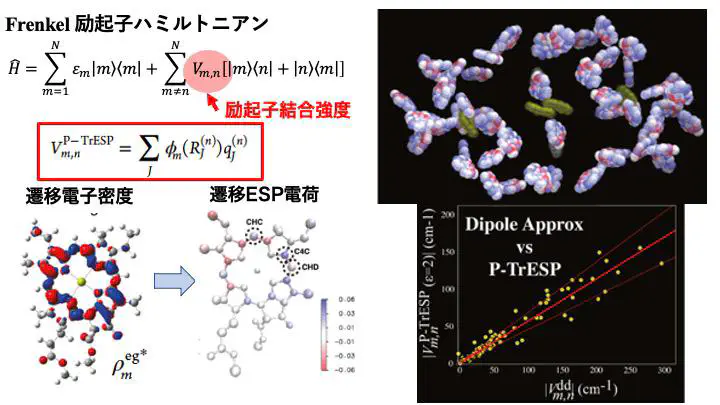Theoretical Calculations of Photosynthesis

To theoretically investigate the light-harvesting mechanisms of photosynthesis, it is essential to calculate site energies and exciton interactions of the antenna pigments based on the structural information of photosynthetic reaction centers (RCs) and light-harvesting antenna proteins and to construct the corresponding exciton Hamiltonian.
Our research has centered on the Heliobacterium Reaction Center (hRC), a non-oxygenic type I photosynthetic reaction center, whose X-ray crystal structure was first reported in 2017. In contrast, oxygenic photosynthetic organisms possess type I and type II reaction centers, known as photosystem I (PSI) and photosystem II (PSII), whose structures have already been well characterized.
Key structural differences between PSI and hRC include:
PSI in cyanobacteria forms a heterodimer, whereas hRC adopts a homodimeric structure.
PSI contains 96 Chlorophyll-a molecules in its core complex and peripheral light-harvesting proteins. At the same time, hRC has a simpler antenna system, consisting of only 54 bacteriochlorophyll g (BChl g) and 4 BChl g’ pigments, with no additional peripheral light-harvesting proteins.
These structural distinctions suggest that hRC employs a unique light-harvesting mechanism compared to PSI.
We calculated the exciton coupling strengths between pigments using the Transition Electrostatic Potential Charge (TrESP) method based on quantum chemical calculations to clarify these differences. Our results revealed that the exciton coupling strengths differ significantly even for pigments occupying comparable positions in the pigment arrangements of hRC and PSI.
We performed computational pigment-swapping experiments to identify the underlying causes, virtually replacing the pigments in hRC and PSI. These simulations demonstrated that the following key factors contribute to the distinct exciton coupling distributions:
- The electronic properties of the unique chlorophyll (namely, BChl g) in hRC.
- The specific spatial arrangement of pigments within the hRC complex.
These findings provide new insights into the distinct light-harvesting strategy employed by the heliobacterial reaction center, offering a deeper understanding of the diversity of photosynthetic energy transfer mechanisms.
Furthermore, by applying these techniques to the reaction centers of Acaryochloris organisms and green sulfur photosynthetic bacteria, we are conducting research to comprehensively understand the light-harvesting and electron-transfer mechanisms of type I photosynthetic reaction centers.